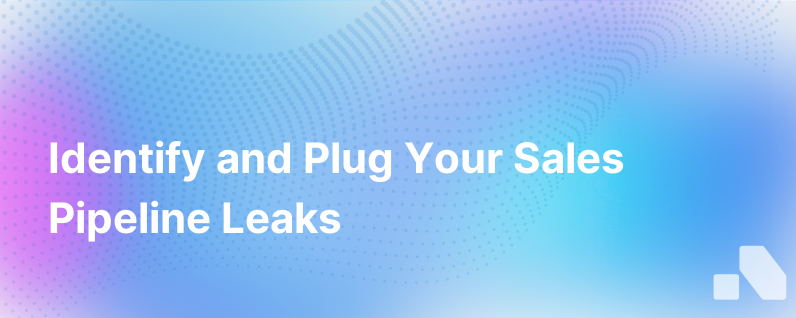
In the digital age, where virtually every business process is mediated through a suite of technologies and platforms, sales and marketing pipelines have become more complex than ever. As professionals navigating this intricate landscape, it's all too common to encounter leaks within our pipelines—areas where prospects drop off, never to engage or progress down the sales funnel.
Identifying and plugging these leaks is not only crucial for optimizing conversion rates but also for ensuring that the efforts and resources invested in acquiring leads don't fade into vanity metrics. Let's navigate the intricate process of solidifying our pipelines.
Understanding the Sales Marketing Pipeline
Simply put, the sales marketing pipeline is a visualization of the journey your prospects take from the moment they discover your brand to the point where they make a purchase—and hopefully beyond, into the realm of loyal, repeat customers.
Steps in the Sales Marketing Funnel:
- Awareness: Prospects become aware of your product or service.
- Interest: They start considering it as a potential solution.
- Consideration: They evaluate your offering against competitors.
- Intent: Showing intention to buy from you.
- Evaluation: Making a final decision.
- Purchase: Finally, they convert and make a purchase.
Spotting the Leaks
Identifying leaks in your sales marketing pipeline is akin to being a detective in your own business—meticulously looking for clues, patterns, and analytics that tell you where the prospects are dropping off.
Common areas where leaks occur include:
- Lead Capture: Poorly designed landing pages or overly complicated forms can deter potential leads.
- Lead Nurturing: Inadequate follow-up or irrelevant content can cause leads to lose interest.
- Sales Process: An unclear sales process or lack of communication can lead to prospects feeling neglected.
Metrics to watch:
- Conversion Rates: Between each stage of the funnel. A significant drop-off could indicate a leak.
- Engagement Rates: On email campaigns, social media, and web content.
- Time to Conversion: Extended times may suggest obstacles within the pipeline.
Plugging Pipeline Leaks
1. Optimize Lead Capture Forms
Start by scrutinizing your lead capture forms. Are there too many fields, or unnecessary ones that might deter prospects from signing up? Simplify these forms and ensure that they're user-friendly and only ask for relevant information.
2. Re-Evaluate Your Content Strategy
Your content must resonate with your audience and guide them through the funnel. Each piece of content should have a clear intention and call-to-action (CTA) that leads the prospect to the next logical step.
- Create content that educates and nurtures interest.
- Design content to specifically address different stages in the pipeline.
3. Perfect Your Follow-Up
Speed and relevance are everything in follow-up communications. Leverage marketing automation tools to send personalized emails promptly after a prospect takes action.
Quick follow-up stats:
- The odds of reaching a lead drop significantly after the first hour.
- Personalized emails deliver 6x higher transaction rates.
4. Adapt Sales Communication
Sometimes the leak isn't how you're reaching out but when and who you're reaching out to. Sales reps should be fully in tune with the lead's position in the funnel and communicate accordingly.
- Align sales scripts and communication with the lead's stage.
- Provide sales team with real-time insights into prospect activity.
5. Leverage CRM and Analytics
Your Customer Relationship Management (CRM) software and sales analytics are treasure troves of insight. Dig into the data to understand patterns and behaviors associated with lost leads.
- Analyze points of drop-off.
- Segment data to understand different audiences and tailor strategies to them.
6. Utilize Lead Scoring
Incorporate lead scoring mechanisms to prioritize and tailor your approach to high-potential leads, making sure they don't slip through the cracks due to lack of attention.
- Develop a scoring system based on lead interaction with your content and brand.
- Adjust lead nurturing strategies based on scores.
7. Enhance Lead Nurturing Programs
Lead nurturing is about building relationships over time. Ensure your programs are diversified and multi-channelled, taking advantage of emails, retargeting campaigns, social media interactions, and more.
- Utilize drip email campaigns that provide timely and valuable content.
- Employ retargeting ads to recapture the attention of visitors who didn't convert.
8. Smooth the Transition from Sales to Marketing
A common leak occurs during the handoff from marketing to sales. Ensure that your sales team is aware of all interactions a lead has had with your brand so far.
- Establish a smooth transition through protocols and shared access to CRM data.
- Train both teams on the entire pipeline to provide a seamless experience for leads.
9. Foster a Culture of Continuous Improvement
Adopt an iterative approach to managing your pipeline, one that involves regularly revisiting and refining your strategy based on results and feedback.
- Implement A/B testing to optimize every stage of the sales funnel.
- Continuously train your sales and marketing team on best practices and new tools.
Aomni: A Solution for Seamless Pipeline Management
While the process of identifying and plugging leaks is critical, it requires effort, constant vigilance, and the right set of tools. Leveraging Aomni can streamline this process—providing AI-driven insights for real-time account research, competitive intelligence, and crafting personalized sales content in minutes.
As you tailor strategies and refine your pipeline, Aomni supports your initiative by offering actionable insights, reducing manual analysis, and contributing to a cohesive sales and marketing strategy.
Conclusion
Your sales marketing pipeline is the lifeline of your business. By being proactive in identifying leaks and implementing strategic tactics to plug them, you'll ensure that your resources are invested wisely and that your prospects are smoothly transitioning into becoming long-term customers.
Remember that pipeline optimization is an ongoing process. Continue to analyze, refine, and adapt, and consider leveraging Aomni’s capabilities to gain deeper insights and drive efficiencies across your sales marketing pipeline.